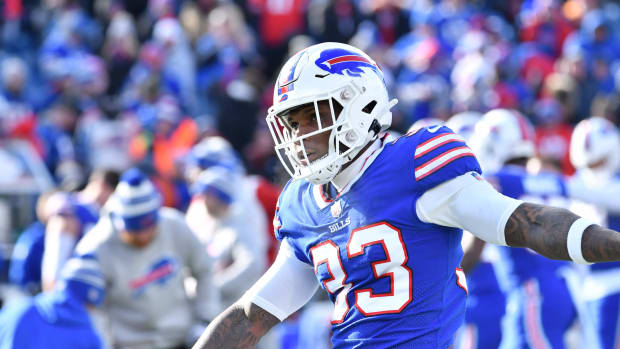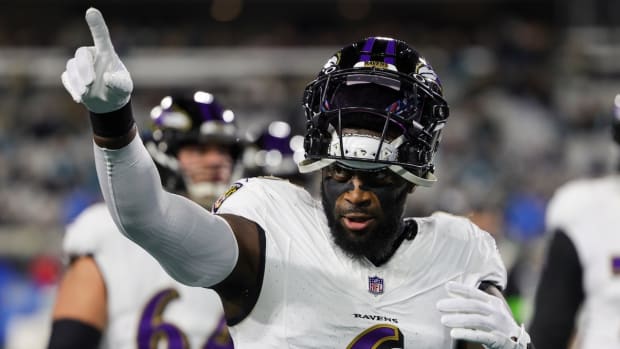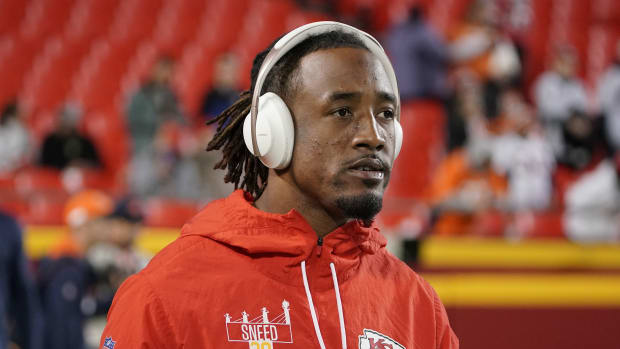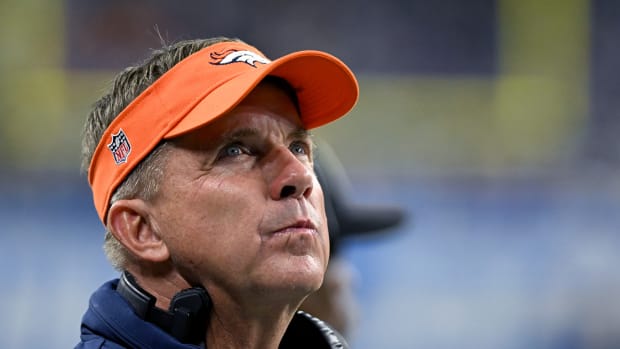Lions Preview: Is This Just Fantasy?
Once again, the Lions will rely on these two to carry them. (Simon Bruty/Sports Illustrated)
OFFENSE
By replacing Jim Schwartz with Jim Caldwell, Lions president Tom Lewand and general manager Martin Mayhew made two tacit declarations about their football team. One: a change in leadership styles is needed; and two: the offense will be the driving force.
First, the leadership. Schwartz was emotional, at times even hot-headed. His club reflected that, often looking like the next generation of Detroit’s Bad Boys—and not always in a good way. Caldwell is even-keeled, sometimes to the point of appearing hypnotized on the sideline (or like something you’d see in a wax museum). He eschews drama and bravado. As veteran linebacker DeAndre Levy put it, “He talks to everybody like men and shoots you straight.”
Whether Caldwell’s calming approach will be beneficial is impossible for anyone outside the organization—and maybe even inside—to forecast. The bigger issue is whether management is right to bet heavily on its offense.
While the Lions are moving to more of a Saints-style system under Caldwell and first-time offensive coordinator Joe Lombardi (formerly the Saints’ QB coach), the gist of the offense will not change much. They’re asking Matthew Stafford to expand mentally—it’s a high volume, verbiage-intensive playbook—but in execution, they’ll almost certainly wind up leaning heavily on the young gunslinger’s physical talent. Which they should; the NFL might not have a better pure arm than Stafford’s.
Caldwell worked with Peyton Manning and Joe Flacco at previous stops. (Leon Halip/Getty Images)
Previous offensive coordinator Scott Linehan expanded a bit from the team’s static, shotgun foundation last year, but not drastically enough to give the Lions a new identity. One could argue that no new identity is needed. In the three years that Stafford has been healthy and at the helm, the Lions have ranked sixth, third and fifth in yardage. Their best player—the one they call Megatron—set single season receiving records in 2012 and was dominant again in 2013. Last season, the arrival of Reggie Bush gave the Lions a more stable ground game, and their passing attack was infused by the third pair of 500-yard receiving backs in NFL history: Bush and Joique Bell.
But one could also argue that a lot of this is just empty productivity, doing little more than pleasing fantasy owners. The offense’s big yardage has not translated to points, as the Lions ranked 13th, 17th and 4th in scoring over those three years. And Calvin Johnson’s record-setting season came amidst a 4-12 campaign, while everyone’s gaudy numbers last year led to seven wins.
When your best players are maxing out their potential and you’re still not winning, doesn’t that suggest a change in approach is needed?
With Caldwell’s and Lombardi’s system, the Lions are betting Stafford matures into an elite quarterback. The physical tools are there; in addition to a hose, Stafford has good pocket toughness and an ability to throw strikes from various platforms. And there might not be a better playmaker late in games (just ask the Cowboys).
But stunting Stafford’s development is inconsistent—if not outright sloppy—mechanics and aggressive decision-making that sometimes spills over into recklessness.
The rest of Detroit’s offense follows their wild stallion’s lead. Calvin Johnson, physical freak that he is, has never been the most disciplined route runner. He hasn’t had to be, but a few times each year this causes problems for the Lions. (To be fair, Johnson has become significantly more refined since early in his career. Last season, however, he offset it with some bad drops.) Bush can create his own yards, but he’ll also give some back by stopping his feet at the expectation of contact. That’s not disciplined, and neither are the fumbles that plagued him in 2013.
It’s hard to envision this offense simply becoming more disciplined in 2014. New wide receiver Golden Tate, who should flourish as a catch-and-run weapon underneath a double-team magnet like Johnson, has never been accused of being overly mature. And first-round rookie tight end Eric Ebron, a superathlete who wedges out the high-jumping Joseph Fauria as the second starting tight end alongside the methodical but viable Brandon Pettigrew, seems destined for a few “welcome to the NFL” moments. The Lions will be willing to live with that because Ebron, alongside Bush, presents a second hybrid playmaker who can beat defenses from anywhere on the field. Even if it’s all shotgun, you can expect increased formation versatility from this club, and probably more no-huddle.
The Lions must resist the temptation to become infatuated with their passing attack and stay committed to balance from the running game. The previous regime finally did this last season. Bush, at 29, is still capable of 1,000 yards, but he’ll need Bell to shoulder at least 40% of the load. There has been tremendous success when Bush and Bell (whose patience makes him great in the screen game) align in the backfield together.
As for the linemen charged with ushering the backs: 14th-year center Dominic Raiola got physically stronger last season and looked the best he has in years. That wasn’t enough, however, to discourage the Lions from drafting his eventual replacement, Travis Swanson, in the third round (a move that Raiola said felt like someone hitting on his wife). At left tackle, light feet helped get Riley Reiff drafted in the first round three years ago, and they should continue to help him hone his technique in pass protection. Reiff is very capable of getting out in front in the ground game. At left guard, Rob Sims has decent short-area movement—something that second-year right guard Larry Warford is also developing. The Lions may want to consider sliding the 330-pound Warford over to right tackle, as the current placeholder there, LaAdrian Waddle, is simply too heavy in the legs to be an NFL starter. In that event, Swanson could step in and get his initial pro experience at guard.
Ndamukong Suh and the front four will key a new-look defense. (Al Tielemans/Sports Illustrated)
DEFENSE
While it remains to be seen just how much the new regime will alter Detroit’s approach on offense, you can bet it will be a completely different game plan on defense. Last season, defensive coordinator Gunther Cunningham (who is now serving as a senior coaching assistant) incorporated more amoeba pre-snap looks and variegated pass-rushing fronts into Schwartz’s otherwise traditional zone-based 4-3 scheme. Still, in the end, the defense remained mostly vanilla.
New defensive coordinator Teryl Austin, a secondary coach Caldwell brought over from Baltimore, figures to expand on the more complex pass-rush packages and coverage rotations that Cunningham and Schwartz dabbled in. The question is whether his personnel will allow him to fully expand.
Regardless of scheme, everything for this defense begins on the front line—and by design. Mayhew has used a high first-round pick on a defensive lineman three out of the last five years. The trio’s first, Ndamukong Suh (second overall in 2010), remains the headliner. Suh’s relentless power and dynamic first step command regular double-teams inside. And, while it’s somewhat under the radar, it makes him a very respectable edge-rusher when he slides outside. Next to Suh is the equally talented but less impactful Nick Fairley (13th overall in 2011), who is blessed with extraordinary burst for someone with his sturdy, rotund build. Fairley and Suh form the most lethal T-T (tackle-tackle) stunt duo in the game, often with Suh selflessly serving as the setup man and Fairley the attacker.
Fairley, entering a contract year (and “coincidentally” having entered camp around 25 pounds lighter than last season) is expected to have a big season, though it could be overshadowed if last year’s No. 5 overall pick, Ziggy Ansah, takes a quantum leap forward. Besides a quick first step, Ansah has tremendous speed-to-power athleticism, like a lankier Dwight Freeney. Though the green 25-year-old led all rookies in sacks last year (eight), he has a long way to go before he’s even close to the class of future Hall of Famer Freeney. It didn’t help that Ansah was sidelined for OTA’s this offseason because of a shoulder injury.
Detroit’s other defensive end, Jason Jones, knows something about being sidelined. After missing 15 games over his first four seasons with the Titans and four games in 2012 with the Seahawks, Jones ruptured his left patella tendon in his third outing as a Lion, missing the rest of the season. As a much-needed insurance policy, Mayhew signed underrated veteran Darryl Tapp (a good leverage-based player) and used a fourth-round pick on Larry Webster, who will compete with last year’s intriguing fourth-rounder Devin Taylor. Don’t be surprised if the lanky Taylor, primarily a pass-rusher, becomes an every-down fixture in the near future.
The linebacking corps should be stronger with second-round rookie Kyle Van Noy stepping in on the strong side. That allows sixth-year veteran DeAndre Levy to play the weak side fulltime. With extra space to run, Levy should be at his best. Last season he had six interceptions, though several of them were cases of being in the right place at the right time. Still, he’s an above average nickel backer, teamed with Stephen Tulloch, a solid read-and-reactor who knows how to blitz.
We won’t know how schematically diverse Austin really is until September, when he has to start making calls for real. Schematic diversity usually stems from how the safeties are used. Free agent pickup James Ihedigbo played for Austin in Baltimore and lends good versatility as a short-area coverage guy and box player. Even more versatile is last year’s free agent pickup, Glover Quin, one of the best man-to-man safeties in the game.
Two significant concerns for this secondary: a lack of depth behind Ihedigbo and Quin, and a paucity of quality man coverage corners. Darius Slay struggled miserably as a second-round rookie last season. Bill Bentley, drafted in the third the year before, has also experienced nightmares in the NFL. Unless fourth-round rookie Nevin Lawson unexpectedly emerges, the Lions could very well be counting on 34-year-old, zone-based ex-Jaguar Rashean Mathis to be their top man-to-man artist.
SPECIAL TEAMS
Seventh-round rookie Nate Freese will have the inside track for the kicking job. Punter Sam Martin ranked 10th in net average last year, though his 10 touchbacks were more than coaches like to see. In the return game, Jeremy Ross will be somewhat feared after taking a kickoff and a punt to the house last season.








































